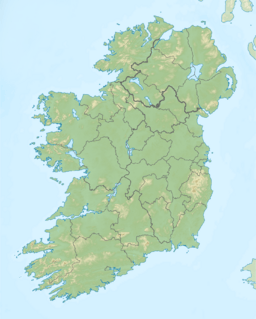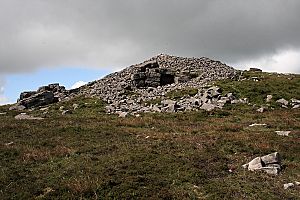Slievenamon facts for kids
Quick facts for kids Slievenamon |
|
|---|---|
| Sliabh na mBan | |

Slievenamon viewed from the northeast
|
|
| Highest point | |
| Elevation | 721 m (2,365 ft) |
| Prominence | 711 m (2,333 ft) |
| Listing | P600, Marilyn, Hewitt |
| Naming | |
| English translation | mountain of the women |
| Language of name | Irish |
| Geography | |
| Location | County Tipperary, Ireland |
| OSI/OSNI grid | S297307 |
| Topo map | OSi Discovery 67 |
Slievenamon (which means "mountain of the women" in Irish) is a famous mountain in County Tipperary, Ireland. It stands tall at 721 meters (about 2,365 feet). The mountain rises from a flat area near towns like Fethard, Clonmel, and Carrick-on-Suir.
Slievenamon is full of old stories and myths. It is closely linked to the legendary Irish hero, Fionn mac Cumhaill. At the very top of the mountain, you can find the remains of ancient burial sites called cairns. People used to believe these cairns were magical doorways to another world, known as the Otherworld. Most of the lower parts of the mountain are covered in trees today. Long ago, almost the entire mountain was a thick forest.
Contents
Discovering Ancient History on Slievenamon
Slievenamon is home to at least four very old monuments from prehistoric times. These are structures built long before written history.
The Summit Cairn
At the very top of the mountain, there is an ancient burial cairn. A cairn is a mound of stones built as a monument or burial place. On its eastern side, a natural rock formation looks like a doorway.
The Ceremonial Avenue
Leading up to this summit cairn from the east, you can see the remains of a "cursus." This was a long, ceremonial path or avenue. It was likely used for special events or processions in ancient times.
Sheegouna's Monuments
On the northeastern side of the mountain, there's an area called Sheegouna. Here, you'll find another burial cairn. There are also parts of a ruined megalithic tomb, which is a large stone structure often used for burials.
Folklore and Legends of Slievenamon
The mountain's name, "mountain of the women," comes from a famous Irish myth.
How Slievenamon Got Its Name
The legend says that the hero Fionn mac Cumhaill was very popular with many young women. He stood on top of Slievenamon and announced a footrace. He said he would marry the woman who reached the summit first. Fionn was secretly in love with Gráinne. So, he showed her a shortcut, and she won the race. Because of this story, the mountain was also known as Sliabh na mBan bhFionn, meaning "mountain of the fair women." Another local idea is that from far away, the mountain looks like a woman lying down.
Magical Fairy Mounds
The flat land around the mountain was called Mag Femin in old Irish. The burial cairns on Slievenamon were known as Síd ar Femin and Sí Ghamhnaí. These names mean "fairy mound over Femen" and "fairy mound of the calves." People believed these mounds were the homes of gods and entrances to the Otherworld. The Otherworld was a magical, hidden realm in Irish mythology. It was thought to be very bad luck to harm or disrespect these ancient tombs.
Gods, Heroes, and Wisdom
In Irish mythology, one of the burial cairns is said to be the home of the god Bodhbh Dearg. Fionn marries Bodhbh's daughter, Sadhbh, on Slievenamon. Their son is the famous warrior-poet Oisín.
In one tale, Fionn and his men were cooking a pig near the River Suir. A creature from the Otherworld, named Cúldubh, came out of a cairn on Slievenamon and stole the pig. Fionn chased Cúldubh and killed him with a spear as he went back into the cairn. An Otherworld woman inside tried to close the door. Fionn's thumb got caught, and he put it in his mouth to ease the pain. Because his thumb had been inside the Otherworld, Fionn gained great wisdom. This story is similar to the tale of the Salmon of Knowledge, where eating a magical fish gives knowledge.
The Fianna's Adventure
In a story called Acallam na Senórach (Dialogue of the Elders), Fionn, Caílte, and other members of the fianna (a group of legendary warriors) chased a fawn to Slievenamon. They found a large, brightly lit hall inside the mountain. There, warriors and maidens from the Otherworld welcomed them. Their host, Donn son of Midir, told them the fawn was one of his maidens. She was sent to lead them to Slievenamon. The fianna agreed to help Donn fight another group of the Tuatha Dé Danann (a race of gods and heroes). After a long battle, Fionn made their enemies agree to peace. Then, the fianna returned to their own world.
Images for kids




